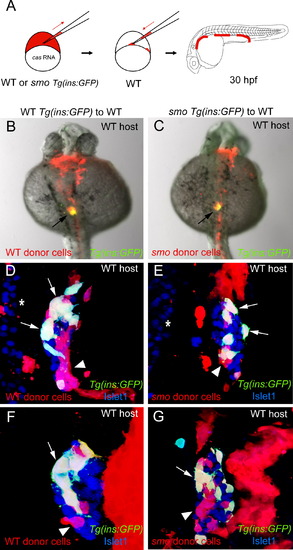Fig. 4
|
Cell-Nonautonomous Requirement of Smoothened Function in the Induction of Dorsal Pancreatic Endocrine Cells (A) Schematic diagram of the cell transplantation protocol. cas-overexpressing wild-type or smo mutant Tg(ins:GFP) donor cells were transplanted into wild-type hosts. (B–G) Wild-type hosts with wild-type (B, D, and F) and smo mutant (C, E, and G) Tg(ins:GFP) donor cells at 30 hpf: dorsal views (B and C) and confocal projections (D–G). All donor cells are labeled with rhodamine dextran (red). Note that only donor cells can express the ins:GFP transgene. (B) Wild-type donor cells contribute to the endoderm and express the ins:GFP transgene in wild-type hosts (arrow; 52%, n = 77/147). (C) smo mutant donor cells contribute to the endoderm and express the ins:GFP transgene (arrow) in wild-type hosts as frequently as wild-type cells do (51%, n = 25/49). (D–G) Hosts were stained for Islet1, which marks all pancreatic endocrine cells (blue) and motoneurons (blue, asterisk). (D and F) Wild-type donor cells differentiate into Islet1-positive endocrine cells (red cytoplasm, blue nucleus; arrowhead), and many of the donor cells coexpress the ins:GFP transgene (triple-positive cells appear white; arrows). (E and G) smo mutant donor cells also differentiate into Islet1-positive endocrine cells (red cytoplasm, blue nucleus; arrowhead), and many of the donor cells coexpress the ins:GFP transgene (triple-positive cells appear white; arrows). Single- and double-channel images are shown in Figure S3. |
Reprinted from Developmental Cell, 14(4), Chung, W.S., and Stainier, D.Y., Intra-endodermal interactions are required for pancreatic beta cell induction, 582-593, Copyright (2008) with permission from Elsevier. Full text @ Dev. Cell

